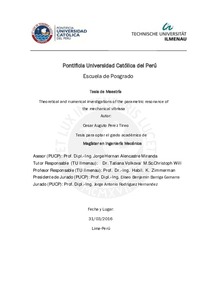| dc.contributor.advisor | Alencastre Miranda, Jorge Hernán | |
| dc.contributor.author | Perez Tineo, Cesar Augusto | es_ES |
| dc.date.accessioned | 2019-02-25T21:26:25Z | es_ES |
| dc.date.available | 2019-02-25T21:26:25Z | es_ES |
| dc.date.created | 2016 | es_ES |
| dc.date.issued | 2019-02-25 | es_ES |
| dc.identifier.uri | http://hdl.handle.net/20.500.12404/13549 | |
| dc.description.abstract | In nature, vibrissae are tactile hairs of mammals used as sensor elements for the exploring the surrounding area. These hairs, also known as whiskers, can be found in different locations on an animals body. Mystacial vibrissae are distributed over a whiskerpad on a muzzle. Carpal vibrissae are located on the downside aspect of the forelimbs of mammals. The vibrissal hair has a conical shape and grows from a special heavily innervated hair follicle incorporating a capsule of blood. As the hair itself has no receptors along its length, the vibrissa may be considered as a system for transmitting forces and torques that arise from the contact between the hair and an object to sensory receptors inside the follicle.
The present thesis deals with the vibrational motion of vibrissae dur- ing natural exploratory behaviour from the mechanical point of view. The phenomenon of the parametric resonance of the vibrissa is investigated the- oretically and numerically. In the first part of this thesis, two mechanical models of an elastic beam are presented based on findings in the literature. The first model considers a straight beam with the linearly decreasing radius of the circular cross-section. The second model takes into account the circu- lar natural configuration of the cylindrical beam. Within these models, the small transverse vibration of the beam under a periodic following force at the tip are analysed using the Euler-Bernoulli beam theory and asymptotic methods of mechanics.
In the second part of the thesis, the numerical analysis of the problems is performed based on the finite element method using ANSYS 16.2 software. For each model, the dynamical response of the system on the parametric excitation is simulated for different frequency values.
It is shown theoretically and numerically that at specific ranges of the excitation frequency the phenomenon of the parametric resonance of the beam takes place. That means that the amplitude of vibrations of the beam increases exponentially with time, when it is stimulated within one of the frequency ranges of the parametric resonance. These ranges depend on the geometrical and material parameters of the beam model, as well as the am- plitude of the periodic excitation. | es_ES |
| dc.description.uri | Tesis | es_ES |
| dc.language.iso | eng | es_ES |
| dc.publisher | Pontificia Universidad Católica del Perú | es_ES |
| dc.rights | info:eu-repo/semantics/openAccess | es_ES |
| dc.rights.uri | http://creativecommons.org/licenses/by-nc/2.5/pe/ | * |
| dc.subject | Mamíferos--Vibración | es_ES |
| dc.subject | Bioingeniería | es_ES |
| dc.subject | Sensores | es_ES |
| dc.title | Theoretical and numerical investigations of the parametric resonance of the mechanical vibrissa | es_ES |
| dc.type | info:eu-repo/semantics/masterThesis | es_ES |
| thesis.degree.name | Maestro en Ingeniería Mecánica | es_ES |
| thesis.degree.level | Maestría | es_ES |
| thesis.degree.grantor | Pontificia Universidad Católica del Perú. Escuela de Posgrado | es_ES |
| thesis.degree.discipline | Ingeniería Mecánica | es_ES |
| renati.advisor.dni | 10588073 | |
| renati.advisor.orcid | https://orcid.org/0000-0001-8442-8255 | es_ES |
| renati.discipline | 713347 | es_ES |
| renati.level | https://purl.org/pe-repo/renati/level#maestro | es_ES |
| renati.type | http://purl.org/pe-repo/renati/type#tesis | es_ES |
| dc.publisher.country | PE | es_ES |
| dc.subject.ocde | https://purl.org/pe-repo/ocde/ford#2.03.01 | es_ES |






